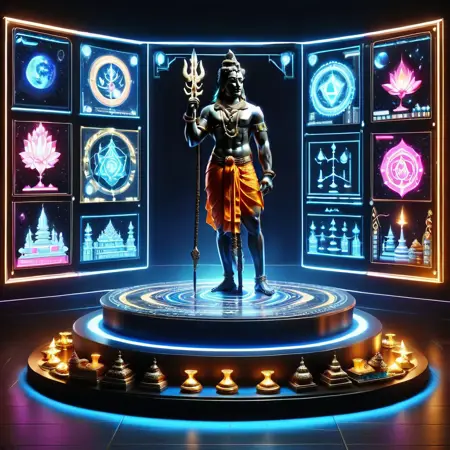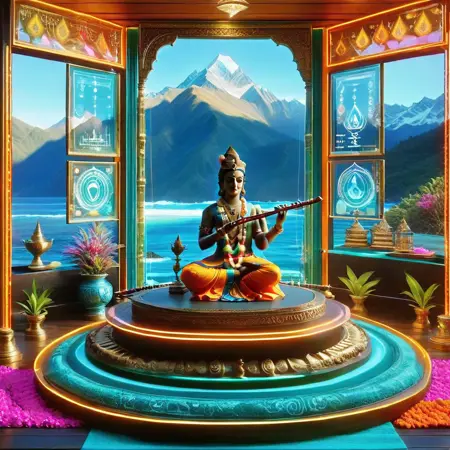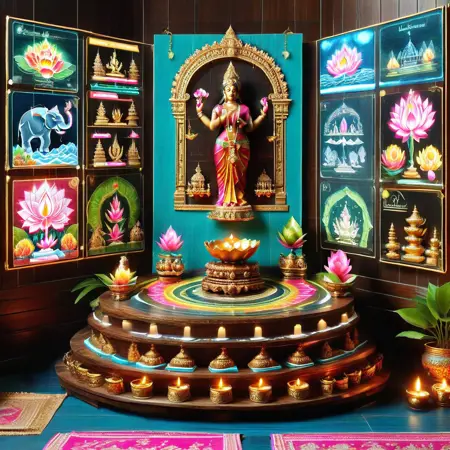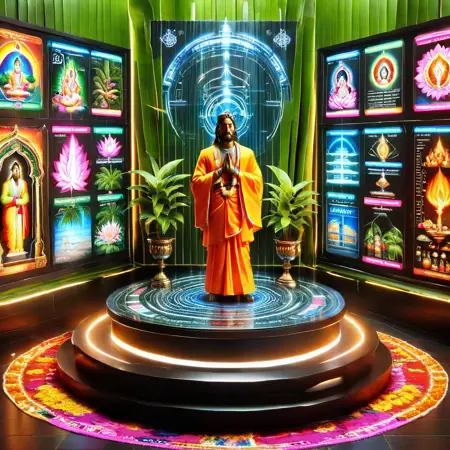Futuristic Pooja Room / Prayer Room SDXL
Details
Download Files
Model description
1. What does the model do?
The "Hindu_Pooja_Room" LORA model generates high-quality, photorealistic images of futuristic Hindu Pooja rooms. It integrates traditional elements (e.g., deity idols, altars, ritual items) with advanced features (/model/377904/display-stand-xl) like holographic displays, smart lighting, and directional sound systems. The model supports various interior design styles (Modern, Rustic, Scandinavian, Bohemian, Tropical) and can depict specific deities (e.g., Lord Shiv, Goddess Lakshmi, Lord Ganesh, Lord Krishna) or even Christian prayer rooms (e.g., Lord Jesus) with customizable backgrounds (e.g., Milky Way, clouds, beach, ocean).
2. What can it be used for?
This LORA model can be used for:
Interior Design Visualization: Creating concept art for modern or futuristic Pooja rooms tailored to specific cultural and spiritual preferences.
Architectural Planning: Assisting architects or homeowners in designing sacred spaces with a blend of tradition and technology.
Art and Media: Generating artwork for spiritual or cultural projects, such as illustrations for books, websites, or exhibitions.
Personal Exploration: Allowing users to experiment with different deities, styles, and settings for personal inspiration or devotion.
Commercial Applications: Supporting designers in creating marketing materials for furniture, décor, or smart home products targeting spiritual spaces.
3. What is this model good at?
The model excels at:
Detailed Spiritual Imagery: Producing clear, high-resolution visuals of Hindu deities (e.g., Lord Shiv with a trident, Goddess Lakshmi with an elephant) with culturally accurate symbols and settings.
Futuristic Aesthetics: Rendering advanced features like 3D holographic idols, glowing platforms, and smart glass boundaries.
Versatile Styles: Adapting to multiple interior design styles (e.g., Scandinavian minimalism, Bohemian vibrancy) while maintaining spiritual authenticity.
Customizable Prompts: Responding well to specific prompts, such as depicting deities in unique environments (e.g., Krishna by the ocean, Ganesh on a beach).
High-Quality Output: Leveraging the SDXL base model and Juggernaut XL checkpoint for photorealistic results at 1024x1024 resolution.
4. How should the model be used?
To use the "Hindu_Pooja_Room" LORA model effectively:
Base Model: Use with the SDXL model (e.g., Juggernaut XL checkpoint) for best compatibility, as it was trained on SDXL.
LORA Integration: Combine with the "Display Stand XL" LORA from CivitAI (trigger word: "Display Stand") for holographic effects. Place both LORA files in the ComfyUI/models/lora/ folder.
Prompt Structure:
Positive Prompts: Specify the design style (e.g., "Hindu_Pooja_Room in modern style"), deity (e.g., "Lord Shiv with clear facial features"), and setting (e.g., "in the Milky Way"). Include details like "divine trident," "hindu symbols," or "blessing devotees" for context.
Negative Prompts: Use terms like "bad eyes, cgi, airbrushed, plastic, deformed, watermark, naked, nude, deformed iris, deformed pupils, distorted face" to avoid artifacts.
Model Strengths: Set the LORA strength to 1 for "Hindu_Pooja_Room" and 0.9–1 for "Display Stand XL" to balance the effects.
ComfyUI Workflow:
Load the Juggernaut XL checkpoint in ComfyUI.
Import both LORAs via the ComfyUI/models/lora/ directory.
Configure prompts and run the workflow to generate 1024x1024 images.
Output Review: Check generated images for clarity, deity accuracy, and style adherence. Adjust prompts or LORA strengths if needed.
5. How should the model not be used?
The model should not be used for:
Inappropriate Content: Generating offensive, disrespectful, or sacrilegious imagery, such as deities in compromising or non-spiritual contexts (e.g., avoid prompts that could lead to "naked" or "deformed" outputs).
Unrelated Themes: Creating visuals unrelated to spiritual or Pooja room contexts, as the model is not trained for general-purpose imagery (e.g., landscapes, animals, or sci-fi without spiritual elements).
Low-Quality Inputs: Using poorly crafted prompts or incompatible base models (e.g., non-SDXL models), which may produce suboptimal results.
Commercial Misuse: Distributing or selling generated images without proper licensing or attribution, especially if they include culturally sensitive elements.
Overreliance on Automation: Expecting perfect results without tweaking prompts or reviewing outputs, as manual adjustments are often needed for optimal quality.







